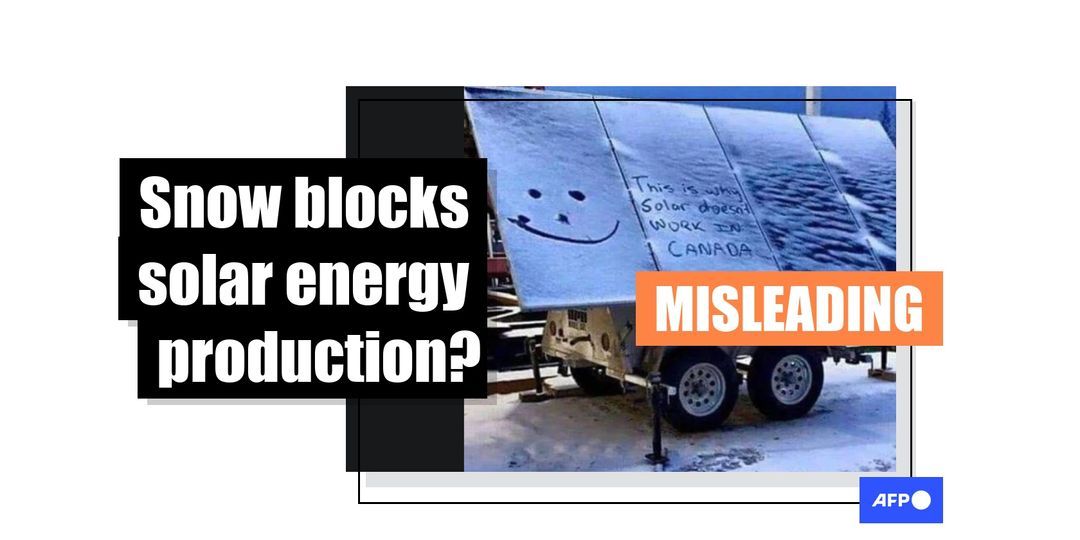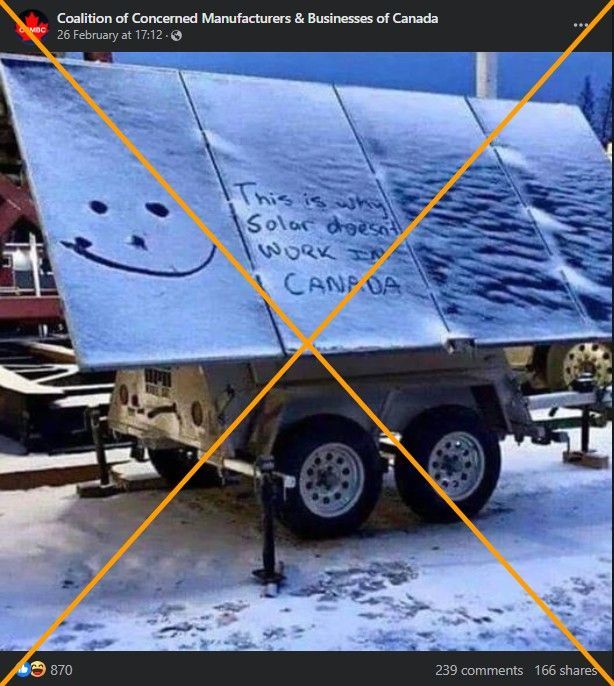
Social media posts claim solar energy is not a viable option in Canadian winters because snow often covers the cells. This is misleading; researchers say heat from the panels quickly melts accumulated snow, thereby minimizing energy production loss.
“This is why solar doesn’t WORK IN CANADA,” says text written in what appears to be a layer of snow covering a solar panel in a photo posted February 27, 2024 on Facebook.
The post generated more than 1,000 reactions and 400 shares.
The same photo, which has circulated online since at least December 2023, received hundreds of likes in other Facebook and Instagram posts.


Other posts have spread similar claims with different visuals implying solar panels are ineffective in the winter.
Snow on a solar panel can affect the amount of energy it produces, according to Koami Soulemane Hayibo, a researcher and PhD candidate in engineering at the University of Western Ontario — but they still work.
“While it’s covered it will still be producing, it’s just that the production will be very minimal,” he told AFP on March 8.
Hayibo said the reduction in productivity is mitigated by the fact that snow can be removed and often melts naturally.
“(With) the heat effect inside the modules they tend to clear themselves,” he said. “It will only be a major problem if there are continuous snowfalls every single day — which is not the case.”
Increasing winter efficiency
Canada aims to generate 90 percent of its electricity from renewable and non-emitting energy sources by 2030 (archived here).
Canada Energy Regulator reported in 2019 that new construction would push the country’s solar production from 2.9 gigawatts to some 3.6 gigawatts over three years — mostly with projects in the sunny central prairies (archived here).
While snow can affect output, research indicates the effect is minimal.
A study from the Northern Alberta Institute of Technology in 2016 compared the amount of energy generated by solar panels when snow was removed or left to melt naturally. It found undisturbed snow cover caused a less than five percent loss in production across all the panels (archived here and here).
New technologies can further pare down the losses.

A 2022 study from Hayibo of the University of Western Ontario looked at bifacial modules that generate energy from the front and back of the panel — which can be even more productive with a layer of white snow covering the ground (archived here).
“Because the ground is covered in snow, it actually tends to reflect more light,” he said. “The bifacial will not only shed the heat faster, they will generate more energy.”
Hayibo said that while bifacial modules do not make up a large share of the market, their popularity is increasing.
Heather MacKenzie, executive director of the nonprofit Solar Alberta, agreed, saying large solar farms are increasingly adopting such models. Those that do not have them often remove snow with a soft brush that avoids damaging the panels, she added.
Solar at home
MacKenzie does not recommend homeowners remove snow from their residential systems, as panels are often on roofs and most removal tools can impair them. However, much like in a solar field, arrays at home will quickly heat up and melt snow.
She added that most solar users in the province of Alberta are hooked up to the electric grid, which can provide extra energy if a home system cannot meet demand due to exceptionally snowy or overcast days.
“It basically serves as a backup battery for everybody, so there’s no reliability issues,” MacKenzie said.
She pointed to credit systems that reward the overproduction of solar energy in the summer with lower electricity bills when users have to rely on the grid (archived here).
More of AFP’s reporting on misinformation in Canada is available here.
